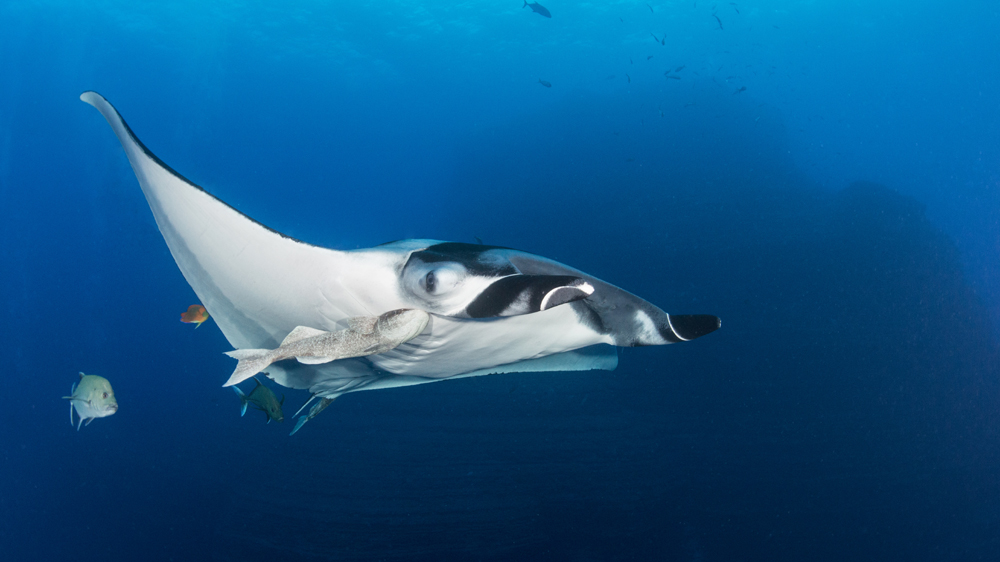Marine Life & Conservation Blogs
Creature Feature: Oceanic Manta Ray

 In this series, the Shark Trust will be sharing amazing facts about different species of sharks and what you can do to help protect them.
In this series, the Shark Trust will be sharing amazing facts about different species of sharks and what you can do to help protect them.
This month our Creature Feature is from guest writer – Yolanda Evans. 17-year old Yolanda has been passionate about sharks all her life, and this month she explores the world of the Oceanic Manta Ray…
The graceful Oceanic Manta Ray dances their way through the blue waters with a wingspan of 7 metres which can reach a maximum of 9 metres, making them the biggest ray in the world. These manta’s have a circumglobal distribution and are found in temperate, tropical, and subtropical. They have a deep black dorsal side with a white T marking on their back and the ventral side is white with black freckles. However, they can be easily confused with Reef Manta’s, but the two main differentiating features (despite their size) is that the white markings on the Reef Manata make a Y shape and there are no freckles on their underside.
Recognisable by the two mouth parts known as the cephalic lobes: extensions of their massive pectoral fins that are used for feeding, helping the ray scoop mouthfuls of plankton. They must eat 20-30 kg of plankton a day, which is only about 2% of their total body weight.
Oceanic Manta’s can have up to 4000 tiny teeth but they don’t use these for feeding, they use them for when they are mating as the males have to hold themselves onto the females! The cephalic lobes can either be flexed out-seen when they are feeding, or curled up for spiral swimming and doing underwater flips!
Having the largest brain to body ratio of any cold-blooded fish, it is thought that they are able to pass the mirror test, showing that they have self-awareness! They are also capable of creating mental maps using smells and environmental barings, helping on their migrations.
Gatherings of these manta’s are rare, but when they come together it is an elegant marine ballet! A group of manta’s, known as a squadron, typically gather for two main reasons: mating and feeding. Manta’s will do somersaults in areas rich in prey to maximise their intake of prey. They will also participate in chain-feeding, this is when each manta follows the other in a circle to create a whirlpool which traps their prey inside!
Cleaning and maintenance is very important to these fish as they will undergo special migrations to coral reefs where Cleaner fish come and groom off parasites and dead skin. These cleaning stations are so important to these rays that they will go back to the same spot for many years!
Out of all elasmobranchs the Giant Manta has one of the slowest reproduction rates, only producing one pup every two to three years and can be pregnant for 12-13 months! However, due to commercial fishing and bycatch, they cannot keep up with the extortionate rate that their populations are decreasing by. This has led to the Oceanic Manta Ray to be listed as endangered by the IUCN. Manta’s are targeted for their gill rakers by traditional medicines that can reach up to $400 USD per kg.
Not only are Oceanic Manta’s threatened by fishing, but also by pollution in the oceans. Microplastics and heavy metals accumulate in their tissues. This can unfortunately lead to serious illnesses like cancers.
SCIENTIFIC NAME: Mobula birostris
FAMILY: Mobulidae
MAXIMUM WINGSPAN: 8.8m
DIET: Filter feeds for plankton, but also consumes deep water fish
DISTRIBUTION: Widespread distribution in tropical and temperate waters worldwide
HABITAT: Ocean-going. Surface to deep waters – 1,000m.
CONSERVATION STATUS:
Images: Frogfish Photography
For more amazing facts about sharks and what you can do to help the Shark Trust protect them visit the Shark Trust website by clicking here.
Marine Life & Conservation Blogs
Creature Feature: Dusky Shark

 In this series, the Shark Trust will be sharing amazing facts about different species of sharks and what you can do to help protect them.
In this series, the Shark Trust will be sharing amazing facts about different species of sharks and what you can do to help protect them.
This month we’re taking a look at the Dusky Shark, a highly migratory species with a particularly slow growth rate and late age at maturity.
Dusky sharks are one of the largest species within the Carcharhinus genus, generally measuring 3 metres total length but able to reach up to 4.2 metres. They are grey to grey-brown on their dorsal side and their fins usually have dusky margins, with the darkest tips on the caudal fin.
Dusky Sharks can often be confused with other species of the Carcharhinus genus, particularly the Galapagos Shark (Carcharhinus galapagensis). They have very similar external morphology, so it can be easier to ID to species level by taking location into account as the two species occupy very different ecological niches – Galapagos Sharks prefer offshore seamounts and islets, whilst duskies prefer continental margins.
Hybridisation:
A 2019 study found that Dusky Sharks are hybridising with Galapagos Sharks on the Eastern Tropical Pacific (Pazmiño et al., 2019). Hybridisation is when an animal breeds with an individual of another species to produce offspring (a hybrid). Hybrids are often infertile, but this study found that the hybrids were able to produce second generation hybrids!
Long distance swimmers:
Dusky sharks are highly mobile species, undertaking long migrations to stay in warm waters throughout the winter. In the Northern Hemisphere, they head towards the poles in the summer and return southwards towards the equator in winter. The longest distance recorded was 2000 nautical miles!
Very slow to mature and reproduce:
The Dusky Shark are both targeted and caught as bycatch globally. We already know that elasmobranchs are inherently slow reproducers which means that they are heavily impacted by overfishing; it takes them so long to recover that they cannot keep up with the rate at which they are being fished. Dusky Sharks are particularly slow to reproduce – females are only ready to start breeding at roughly 20 years old, their gestation periods can last up to 22 months, and they only give birth every two to three years. This makes duskies one of the most vulnerable of all shark species.
The Dusky Shark is now listed on Appendix II of the Convention on the Conservation of Migratory Species (CMS), but further action is required to protect this important species.
Scientific Name: Carcharhinus obscurus
Family: Carcharhinidae
Maximum Size: 420cm (Total Length)
Diet: Bony fishes, cephalopods, can also eat crustaceans, and small sharks, skates and rays
Distribution: Patchy distribution in tropical and warm temperate seas; Atlantic, Indo-Pacific and Mediterranean.
Habitat: Ranges from inshore waters out to the edge of the continental shelf.
Conservation status: Endangered.
For more great shark information and conservation visit the Shark Trust Website
Images: Andy Murch
Diana A. Pazmiño, Lynne van Herderden, Colin A. Simpfendorfer, Claudia Junge, Stephen C. Donnellan, E. Mauricio Hoyos-Padilla, Clinton A.J. Duffy, Charlie Huveneers, Bronwyn M. Gillanders, Paul A. Butcher, Gregory E. Maes. (2019). Introgressive hybridisation between two widespread sharks in the east Pacific region, Molecular Phylogenetics and Evolution 136(119-127), https://doi.org/10.1016/j.ympev.2019.04.013.
Marine Life & Conservation Blogs
Creature Feature: Undulate Ray

 In this series, the Shark Trust will be sharing amazing facts about different species of sharks and what you can do to help protect them.
In this series, the Shark Trust will be sharing amazing facts about different species of sharks and what you can do to help protect them.
This month we’re looking at the Undulate Ray. Easily identified by its beautiful, ornate pattern, the Undulate Ray gets its name from the undulating patterns of lines and spots on its dorsal side.
This skate is usually found on sandy or muddy sea floors, down to about 200 m deep, although it is more commonly found shallower. They can grow up to 90 cm total length. Depending on the size of the individual, their diet can range from shrimps to crabs.
Although sometimes called the Undulate Ray, this is actually a species of skate, meaning that, as all true skates do, they lay eggs. The eggs are contained in keratin eggcases – the same material that our hair and nails are made up of! These eggcases are also commonly called mermaid’s purses and can be found washed up on beaches all around the UK. If you find one, be sure to take a picture and upload your find to the Great Eggcase Hunt – the Shark Trust’s flagship citizen science project.
It is worth noting that on the south coasts, these eggcases can be confused with those of the Spotted Ray, especially as they look very similar and the ranges overlap, so we sometimes informally refer to them as ‘Spundulates’.
Scientific Name: Raja undulata
Family: Rajidae
Maximum Size: 90cm (total length)
Diet: shrimps and crabs
Distribution: found around the eastern Atlantic and in the Mediterranean Sea.
Habitat: shelf waters down to 200m deep.
Conservation Status : As a commercially exploited species, the Undulate Ray is a recovering species in some areas. The good thing is that they have some of the most comprehensive management measures of almost any elasmobranch species, with both minimum and maximum landing sizes as well as a closed season. Additionally, targeting is entirely prohibited in some areas. They are also often caught as bycatch in various fisheries – in some areas they can be landed whilst in others they must be discarded.
IUCN Red List Status: Endangered
For more great shark information and conservation visit the Shark Trust Website
Image Credits: Banner – Sheila Openshaw; Illustration – Marc Dando
-

 News3 months ago
News3 months agoHone your underwater photography skills with Alphamarine Photography at Red Sea Diving Safari in March
-

 News3 months ago
News3 months agoCapturing Critters in Lembeh Underwater Photography Workshop 2024: Event Roundup
-

 Marine Life & Conservation Blogs3 months ago
Marine Life & Conservation Blogs3 months agoCreature Feature: Swell Sharks
-

 Blogs2 months ago
Blogs2 months agoMurex Resorts: Passport to Paradise!
-

 Blogs2 months ago
Blogs2 months agoDiver Discovering Whale Skeletons Beneath Ice Judged World’s Best Underwater Photograph
-

 Gear Reviews2 weeks ago
Gear Reviews2 weeks agoGEAR REVIEW – Revolutionising Diving Comfort: The Sharkskin T2 Chillproof Suit
-

 Marine Life & Conservation2 months ago
Marine Life & Conservation2 months agoSave the Manatee Club launches brand new webcams at Silver Springs State Park, Florida
-

 Gear Reviews3 months ago
Gear Reviews3 months agoGear Review: Oceanic+ Dive Housing for iPhone






















